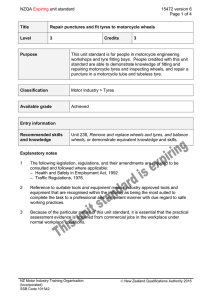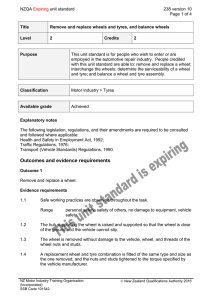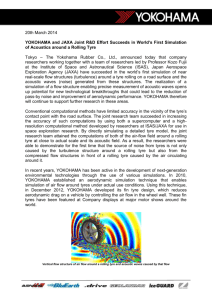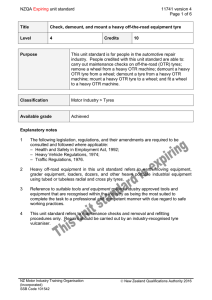NZQA unit standard 916 version 6
advertisement
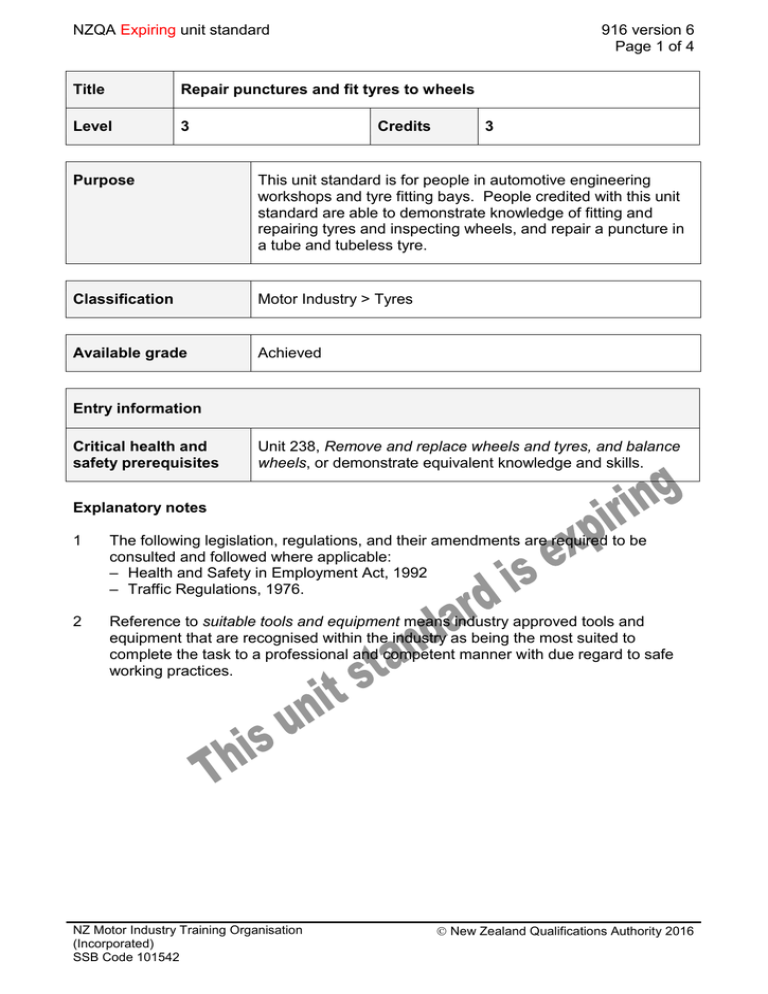
NZQA Expiring unit standard 916 version 6 Page 1 of 4 Title Repair punctures and fit tyres to wheels Level 3 Credits 3 Purpose This unit standard is for people in automotive engineering workshops and tyre fitting bays. People credited with this unit standard are able to demonstrate knowledge of fitting and repairing tyres and inspecting wheels, and repair a puncture in a tube and tubeless tyre. Classification Motor Industry > Tyres Available grade Achieved Entry information Critical health and safety prerequisites Unit 238, Remove and replace wheels and tyres, and balance wheels, or demonstrate equivalent knowledge and skills. Explanatory notes 1 The following legislation, regulations, and their amendments are required to be consulted and followed where applicable: – Health and Safety in Employment Act, 1992 – Traffic Regulations, 1976. 2 Reference to suitable tools and equipment means industry approved tools and equipment that are recognised within the industry as being the most suited to complete the task to a professional and competent manner with due regard to safe working practices. NZ Motor Industry Training Organisation (Incorporated) SSB Code 101542 New Zealand Qualifications Authority 2016 NZQA Expiring unit standard 916 version 6 Page 2 of 4 Outcomes and evidence requirements Outcome 1 Demonstrate knowledge of fitting and repairing tyres and inspecting wheels. Evidence requirements 1.1 Safety precautions when demounting and mounting tyres are described according to tyre and tyre equipment manufacturer’s instructions. Range 1.2 using compressed air, tyre and tube inflation, wheel support, using a tyre changing machine, using a safety cage, using hand tools and tyre tools. Wheel and tyre handling precautions are described according to tyre and tyre equipment manufacturer’s instructions. Range prevention of damage to wheel rims and tyre beads, valve positioning, avoidance of tube pinching and folding, seating of tyre beads, cleaning, inspection and lubricating wheel assemblies. Outcome 2 Repair a puncture in a tube and tubeless tyre. Evidence requirements 2.1 Safe working practices are observed throughout the task. Range personal safety, safety of others, equipment safety. 2.2 Suitable tools and equipment are selected and used to enable tyres to be repaired and replaced. 2.3 The wheel and tyre assembly is inspected, and its condition is determined. Range 2.4 pressure loss, tyre wear, wheel damage, tyre impact damage, casing failure. Demounting and mounting tyres are carried out according to the rim type. Range passenger car and light commercial drop centre rim, motorcycle types, split rim type, truck and heavy equipment flat base rim, truck drop centre rim, agricultural and heavy equipment where ballasting is required. NZ Motor Industry Training Organisation (Incorporated) SSB Code 101542 New Zealand Qualifications Authority 2016 NZQA Expiring unit standard 2.5 The disassembled wheel and tyre assembly components are inspected, and their suitability for repair is determined. Range 2.6 inner casing damage, beading damage, compliance to Traffic Regulations 1976, valve, wheel rim(s), rusting, wheel damage, tube damage. The puncture is repaired to tyre manufacturer's recommendations and the puncture repair kit instructions, depending on the type of tyre, and size and location of the puncture. Range 2.7 916 version 6 Page 3 of 4 patches and plugs to the tyre without the application of heat using chemical and adhesive solutions, patches and plugs vulcanised in place by the application of localised heat with a spot vulcaniser, tubes repaired with a cold vulcanising repair kit. The size and type of replacement tyres and tubes are selected to conform to that of the wheel, and the vehicle manufacturer's and customer's requirements. Replacement information This unit standard and unit standard 9074 have been replaced by unit standard 24457 and unit standard 24458. This unit standard is expiring. Assessment against the standard must take place by the last date for assessment set out below. Status information and last date for assessment for superseded versions Process Version Date Last Date for Assessment Registration 1 29 October 1993 31 December 2016 Review 2 4 October 1996 31 December 2016 Review 3 26 February 1999 31 December 2016 Review 4 25 January 2008 31 December 2016 Rollover 5 19 November 2010 31 December 2016 Rollover 6 18 February 2016 31 December 2020 Consent and Moderation Requirements (CMR) reference 0014 This CMR can be accessed at http://www.nzqa.govt.nz/framework/search/index.do. Please note Providers must be granted consent to assess against standards (accredited) by NZQA, or an inter-institutional body with delegated authority for quality assurance, before they can report credits from assessment against unit standards or deliver courses of study leading to that assessment. NZ Motor Industry Training Organisation (Incorporated) SSB Code 101542 New Zealand Qualifications Authority 2016 NZQA Expiring unit standard 916 version 6 Page 4 of 4 Industry Training Organisations must be granted consent to assess against standards by NZQA before they can register credits from assessment against unit standards. Providers and Industry Training Organisations, which have been granted consent and which are assessing against unit standards must engage with the moderation system that applies to those standards. Consent requirements and an outline of the moderation system that applies to this standard are outlined in the Conesnt and Moderation Requirements (CMR). The CMR also includes useful information about special requirements for organisations wishing to develop education and training programmes, such as minimum qualifications for tutors and assessors, and special resource requirements. NZ Motor Industry Training Organisation (Incorporated) SSB Code 101542 New Zealand Qualifications Authority 2016

